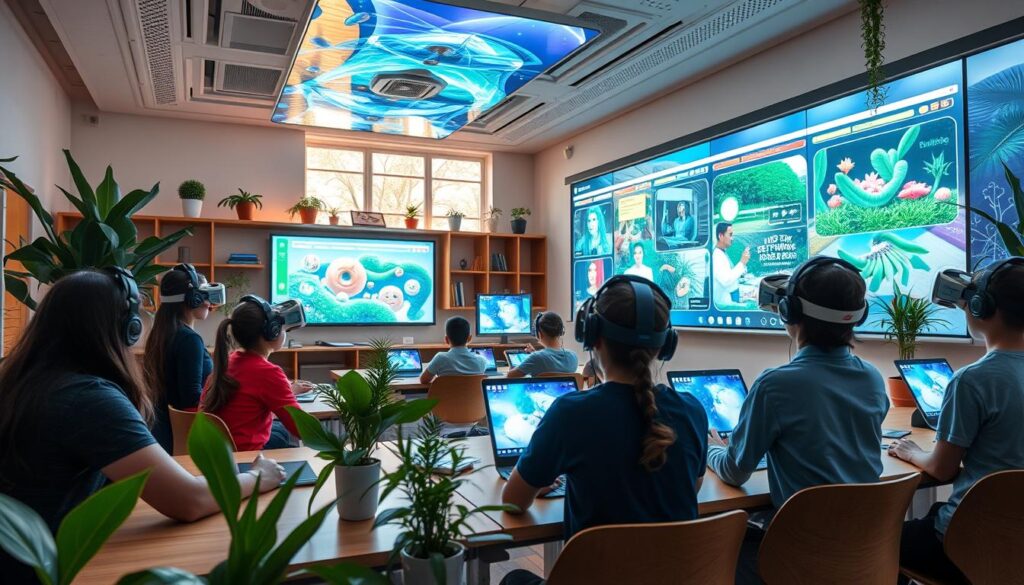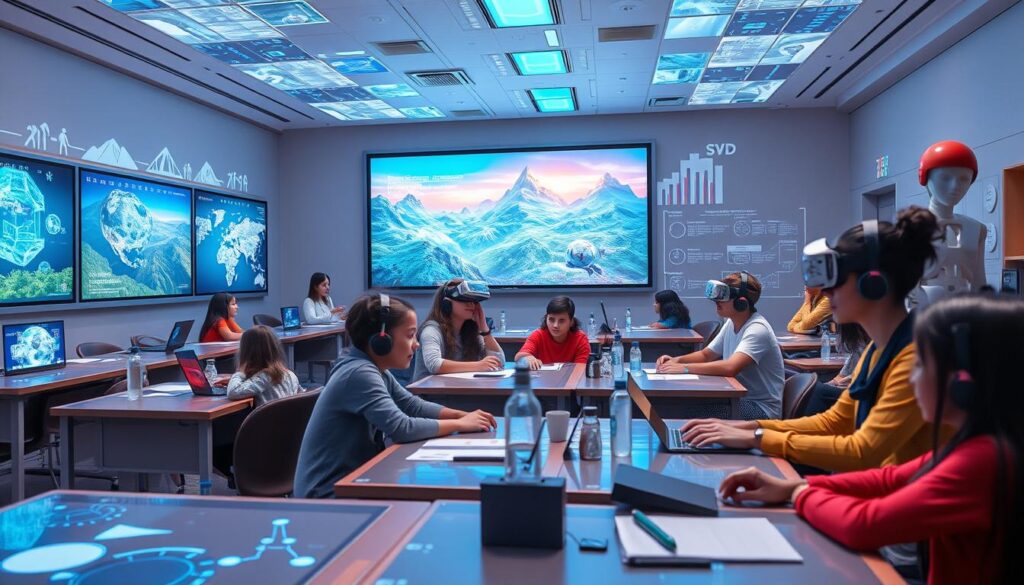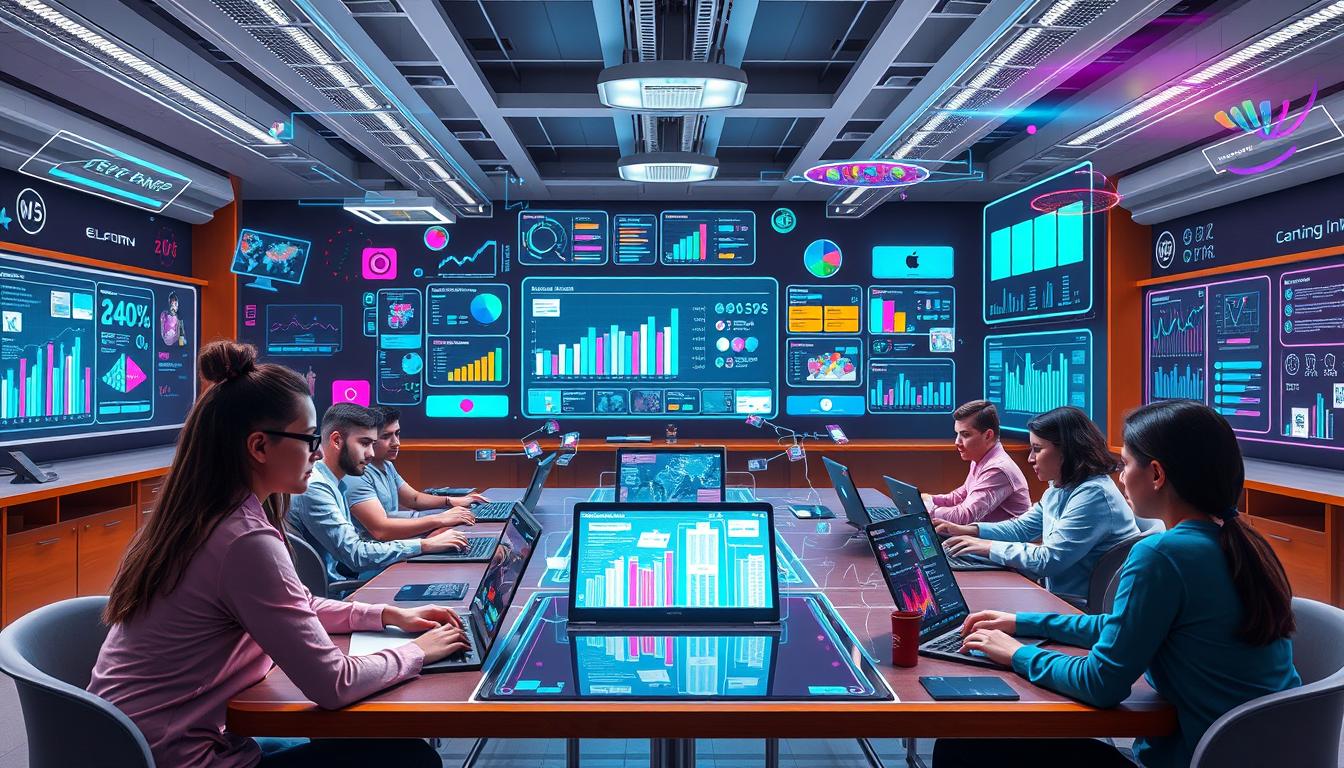In today’s world, technology has transformed every aspect of our lives, including education. A recent study found that over 6 million students in the United States are taking at least one online course. This shift from traditional classrooms to online learning highlights the significant role of internet-based education in shaping the future of learning.
The rise of e-learning, online education, and digital learning platforms has changed how we learn and teach. The internet has enabled virtual classrooms and interactive tools, leading to a modern educational revolution. It empowers both students and educators to explore new possibilities in education.
Key Takeaways
- The rapid growth of internet-based learning is transforming the educational landscape in the United States.
- Online courses and digital learning platforms are becoming increasingly popular among students, offering greater flexibility and accessibility.
- Technology has enabled new teaching methodologies and interactive learning experiences, revolutionizing the way knowledge is acquired and shared.
- The future of education is closely intertwined with the continued evolution of internet-based learning solutions.
- Embracing the potential of internet-based learning is crucial for staying ahead in the rapidly changing educational ecosystem.
Understanding Internet-Based Learning: A Modern Educational Revolution
The education landscape has dramatically changed, moving from traditional classrooms to virtual classrooms and web-based training. This digital shift has brought a new era of educational technology. It’s changing how we view learning.
The Evolution from Traditional to Digital Learning
Students are no longer limited to physical schools. Internet-based learning has opened up vast opportunities. It allows learners to access educational resources from home or on the move. This change has not only increased education’s reach but also made it more flexible and tailored to individual needs.
Key Components of Online Education Systems
- Interactive learning platforms
- Engaging multimedia content
- Real-time virtual classrooms
- Collaborative learning tools
- Comprehensive learning management systems (LMS)
Current State of E-Learning Technologies
Web-based training and virtual classrooms have transformed education. With advancements like cloud-based LMS and AI-powered adaptive learning systems, the e-learning sector is always evolving. It offers learners a more immersive and personalized educational journey.
“The future of education is undoubtedly digital, as virtual classrooms and web-based training continue to redefine the way we learn and grow.”
Exploring internet-based learning reveals it’s not just a trend. It’s a transformative force reshaping education in the 21st century.
Benefits of Virtual Classrooms in Today’s Educational Landscape
In today’s fast-changing educational scene, virtual classrooms are a game-changer. They offer many benefits for today’s learners. As we move towards remote instruction and distance education, these digital spaces are becoming more common. They’re changing how we view online education.
Virtual classrooms stand out for their flexibility. Students can access materials, join live discussions, and work with peers from home. This breaks down barriers and fits into different schedules. It makes education more accessible and fair for everyone.
Also, virtual classrooms offer a personalized learning experience. Teachers can adjust content and methods to meet each student’s needs. With technology, they can give feedback, assessments, and learning plans tailored to each student. This ensures students learn at their own speed and get the help they need.
“Virtual classrooms have the potential to revolutionize education, democratizing access to high-quality learning experiences and empowering students to thrive in the digital age.”
Virtual classrooms also boost collaboration and engagement. Students can join group discussions, share ideas, and work on projects together. This builds a community and support that’s key to learning success.
The role of virtual classrooms in education is huge. They meet the needs of today’s learners and use technology to its fullest. These digital spaces are shaping the future of education. They’re making learning more accessible, personalized, and engaging for everyone.
Digital Learning Tools and Technologies Shaping Education
In the ever-evolving landscape of education, digital learning tools and technologies are at the forefront of transforming the way we acquire knowledge. From innovative Learning Management Systems (LMS) to engaging interactive platforms, the educational technology revolution is redefining the learning experience for students and educators alike.
Learning Management Systems (LMS)
A powerful cornerstone of e-learning, Learning Management Systems provide a centralized platform for managing and delivering multimedia courses. These versatile systems enable educators to create, distribute, and track the progress of online learning materials. This fosters a seamless and organized educational journey for students.
Interactive Learning Platforms
Beyond traditional LMS capabilities, educational technology has given rise to interactive learning platforms that captivate students and enhance the overall learning experience. These platforms often incorporate multimedia elements, gamification, and collaborative tools. They allow students to actively engage with the content and one another.
Educational Apps and Software
In the digital age, a vast array of specialized educational apps and software have emerged to cater to the diverse needs of learners. From interactive study aids and virtual simulations to personalized learning assistants, these tools provide students with a personalized and engaging educational experience. They are tailored to their individual learning styles and preferences.
“The future of education is digital, and the tools we have at our disposal today are transforming the way we learn and teach.”
As the educational landscape continues to evolve, these digital learning tools and technologies will undoubtedly play an increasingly crucial role in shaping the future of education. They empower students and educators alike to achieve their academic and professional goals.
The Role of Multimedia in Online Education
In the digital learning world, multimedia has changed how students interact with course materials. From multimedia courses to interactive simulations, these tools are key to web-based training. They help learners grasp and remember complex ideas better.
Integrating multimedia into digital learning captivates and motivates students. High-quality videos and animations make abstract concepts tangible. This makes learning more engaging and memorable.
- Interactive simulations let students try out real-world scenarios, deepening their understanding.
- Multimedia meets different learning styles, benefiting visual, auditory, and kinesthetic learners. This makes education more inclusive and effective.
- Studies show multimedia courses boost knowledge retention. The mix of visuals and sounds strengthens the learning process.
“Multimedia has the power to transform the way we learn, making complex topics engaging and accessible.”
As digital learning advances, multimedia’s importance in online education will grow. By using these tools in web-based training, educators can offer rich, impactful learning experiences. These experiences prepare students for today’s world challenges.
Remote Instruction: Breaking Geographic Barriers
The rise of distance education and virtual classrooms has transformed the educational landscape. It has broken down geographic barriers, making quality online education available to learners globally. This shift empowers individuals to pursue their academic and professional goals, regardless of their location.
Global Access to Education
Distance education’s ability to transcend borders is remarkable. It brings educational opportunities to the global community. Students can now engage in virtual classrooms and access top-tier academic institutions, foreign language programs, and specialized courses from their homes.
Time Zone Advantages and Challenges
The asynchronous nature of many online education platforms offers both advantages and challenges in terms of time zones. Students can access course materials and participate in discussions at their convenience. However, coordinating live virtual interactions across different time zones requires careful planning and flexibility.
Cross-Cultural Learning Opportunities
Internet-based learning fosters a rich tapestry of cultural exchange and understanding. Virtual classrooms bring together students from diverse backgrounds. They enable students to learn from one another, share perspectives, and cultivate a global mindset. This cross-cultural exchange greatly enhances the educational experience and prepares learners for the interconnected world.
“Distance education has the power to transcend geographic boundaries and bring world-class education to the fingertips of learners everywhere.”
Personalized Learning Through Web-Based Training
In today’s fast-changing educational landscape, web-based training has become a pivotal innovation, ushering in a new era of personalized learning. It leverages digital technologies to customize the learning experience for each student’s unique needs and preferences.
Web-based training excels in utilizing adaptive learning technologies. These advanced systems assess a student’s performance, learning style, and progress. They then adjust the content, pace, and delivery to enhance the learning experience. This tailored approach ensures students receive the necessary support, leading to better learning outcomes.
Furthermore, AI-driven content recommendations in these platforms suggest learning materials and activities that match a student’s interests and strengths. This personalized curation allows learners to delve into topics that genuinely interest them, deepening their engagement with digital learning.
Moreover, web-based training enables the creation of customized learning paths. Students can progress through their educational journey at their own pace, catering to their individual needs. This flexibility is especially valuable for learners with diverse backgrounds, learning styles, and goals, ensuring inclusivity in the e-learning era.
“Web-based training has the power to transform education, enabling a future where every student can reach their full potential through personalized learning experiences.”
As education continues to evolve, web-based training remains at the forefront. It empowers students to reach their full potential and sets the stage for a future where personalized learning is the standard, not the exception.

Student Engagement in Virtual Learning Environments
In the rapidly changing world of online education, engaging students in virtual classrooms is a major challenge. Educators and institutions are looking into new ways to keep students interested and involved. They aim to make these digital classrooms more dynamic and interactive.
Interactive Assessment Methods
Interactive assessment methods are crucial for engaging students in virtual learning. These methods move beyond simple multiple-choice tests. They include:
- Gamified quizzes and assessments
- Multimedia-based assignments
- Peer-to-peer feedback mechanisms
- Real-time performance tracking
These techniques not only check on student progress but also promote active learning. They help students feel more invested in their educational journey.
Collaborative Learning Tools
Encouraging students to work together in virtual classrooms is another effective strategy. Online education technology offers many tools for collaboration, such as:
- Virtual study groups and discussion forums
- Shared whiteboards and document collaboration
- Video conferencing for group projects
- Peer review and feedback platforms
These tools allow students to collaborate, share ideas, and learn from each other. They make the virtual classroom more engaging and interactive.
Gamification in Education
Using gamification in online education is a powerful way to boost student engagement. By adding game-like elements, such as points and badges, educators can motivate students. This encourages them to participate, compete, and reach their learning goals.
“Gamification has the potential to transform the way we approach educational technology. It can make learning more immersive, engaging, and rewarding for students.”
As virtual learning evolves, keeping students engaged will become even more critical. It will shape the future of online education.
The Impact of Educational Technology on Learning Outcomes
In the rapidly evolving landscape of education, the integration of educational technology has become a driving force behind enhanced learning outcomes. From interactive e-learning platforms to immersive digital learning environments, the advancements in digital learning tools have revolutionized the way students engage with and retain information.
A growing body of research has consistently demonstrated the positive impact of technology-enhanced learning on academic performance and skill development. Studies have shown that the use of multimedia, interactive simulations, and personalized learning modules can lead to significant improvements in student comprehension, knowledge retention, and overall academic achievement.
“The integration of educational technology has enabled us to create more engaging and effective learning experiences for our students, empowering them to reach new heights in their academic journeys.” – Dr. Sarah Johnson, Education Researcher
Furthermore, the implementation of educational technology has fostered the development of critical 21st-century skills, such as problem-solving, critical thinking, and collaborative learning. By leveraging digital tools and platforms, students can engage in dynamic, hands-on learning activities that prepare them for the demands of the modern workforce.
As the education sector continues to evolve, the impact of digital learning on student outcomes will only become more pronounced. Educators and policymakers must stay informed about the latest advancements in e-learning technologies and explore ways to seamlessly integrate them into the curriculum. This ensures that learners are equipped with the knowledge and skills necessary to thrive in the digital age.
Challenges and Solutions in Distance Education
The rise of internet-based learning has brought unique challenges to distance education. It demands innovative solutions, from ensuring strong technical infrastructure to effective student support systems. Online learning programs must evolve to meet the needs of today’s tech-savvy students.
Technical Infrastructure Requirements
Reliable and scalable technology is crucial for a successful distance education program. Students rely on smooth access to course materials, video conferencing, and interactive tools. Investing in advanced Learning Management Systems (LMS), high-speed internet, and cloud storage can solve technical issues. This ensures a seamless learning experience.
Student Support Systems
An effective distance education system needs a comprehensive support network. It must address the unique needs of online learners. This includes technical help, academic advising, mental health resources, and career guidance. A strong support system helps students overcome internet-based learning challenges and achieve academic success.
Quality Assurance in Online Learning
Ensuring high-quality education is vital in the fast-changing world of online education. Implementing rigorous curriculum reviews, peer evaluation, and data-driven assessments is key. These steps help maintain the quality and relevance of distance education programs. Additionally, ongoing professional development for instructors enhances their ability to deliver engaging virtual lessons.
“The future of education is not in the classroom, but in the virtual world. By embracing the power of internet-based learning, we can unlock new opportunities and transform the way we acquire knowledge.”
Future Trends in Internet-Based Learning
The world of internet-based learning is on the cusp of a revolution, with new technologies poised to reshape education. Internet-based learning, also known as e-learning or educational technology, is on the verge of embracing groundbreaking innovations. These advancements will redefine the future of online education.
Augmented reality (AR) and virtual reality (VR) are set to transform virtual classrooms. These immersive technologies promise to deliver engaging learning experiences. Students will interact with digital content in ways previously unimaginable. Picture virtual field trips to historical sites or simulated science experiments – the future is limitless.
Artificial intelligence (AI) is also on the horizon, set to revolutionize personalized learning. AI-powered educational technology will analyze student data to offer customized instruction and feedback. This ensures each learner’s needs are addressed, making education more effective.
Blockchain technology is another innovation that will enhance internet-based learning systems. It will improve security, transparency, and data management. Blockchain-based credentials and digital certificates will allow learners to showcase their achievements easily. This ensures the integrity of their academic records.
“The future of education is not just about technology, but about how we can leverage these advancements to create more personalized, engaging, and accessible learning experiences.”
As these technologies advance, the future of internet-based learning looks both exciting and transformative. It promises to create a more innovative and equitable educational landscape.

Building Effective Online Learning Communities
The digital revolution has transformed education, introducing virtual classrooms, online education, and web-based training. Building effective learning communities is now key to student engagement and success. This shift marks a new era in education.
Social Learning Platforms
Social learning platforms are incredibly powerful. They allow students to connect, collaborate, and share knowledge. These platforms, with their interactive forums and collaborative spaces, create a dynamic environment. They foster a sense of community and belonging among online learners.
Virtual Study Groups
Virtual study groups are also crucial in online learning communities. They enable students to discuss course material and support each other. Through video conferencing and document sharing, these groups bridge the physical divide. They create a vibrant learning ecosystem.
Peer-to-Peer Learning Networks
Peer-to-peer learning networks are gaining popularity in online education. They allow students to share their knowledge and experiences. This creates a rich learning environment where students can gain new perspectives and deepen their understanding.
The evolution of virtual classrooms, online education, and web-based training has changed learning. By using social learning platforms, virtual study groups, and peer-to-peer networks, we can build thriving online communities. These communities inspire, engage, and empower students to achieve academic success.
Measuring Success in Digital Education Programs
The rapid adoption of digital learning and educational technology makes it vital to assess the success of e-learning programs. Educators and institutions must develop effective assessment strategies. This ensures their online courses deliver real benefits to students.
Key performance indicators (KPIs) are crucial for evaluating digital learning initiatives. Metrics include student enrollment, retention rates, course completion, and average grades. Also, tracking engagement, like login frequency and time on materials, offers insights.
Qualitative aspects, such as student satisfaction and skill development, are also important. Feedback surveys, focus groups, and peer evaluations help capture learner perspectives. They reveal areas for improvement.
Data analytics tools have transformed how educators measure and refine e-learning programs. By using LMS and digital platforms, institutions can track student progress and learning patterns. This data informs decisions to enhance digital learning experiences.
“Effective assessment in digital learning is not just about the numbers, but about understanding the holistic impact on student outcomes and the educational experience.”
As the digital learning landscape evolves, a comprehensive and flexible approach to measuring success is key. Institutions must ensure their e-learning programs remain engaging, relevant, and impactful.
Essential Skills for Online Learners and Educators
In the world of internet-based learning, both students and educators need to develop unique skills to succeed. Digital literacy, time management, self-motivation, and effective online communication are key. These skills are vital for navigating the ever-changing landscape of online education and distance learning.
For students, digital literacy is foundational. They must master learning management systems, video conferencing tools, and educational software. This empowers them to engage fully with online course materials. Time management is also crucial, as the flexibility of online learning demands self-discipline to stay on track and meet deadlines.
For educators, adaptability and innovative thinking are essential. They must reinvent traditional teaching methods to create engaging, interactive learning experiences. Effective communication skills, both written and verbal, are necessary. They enable educators to build meaningful connections with students and guide them through the virtual classroom.

